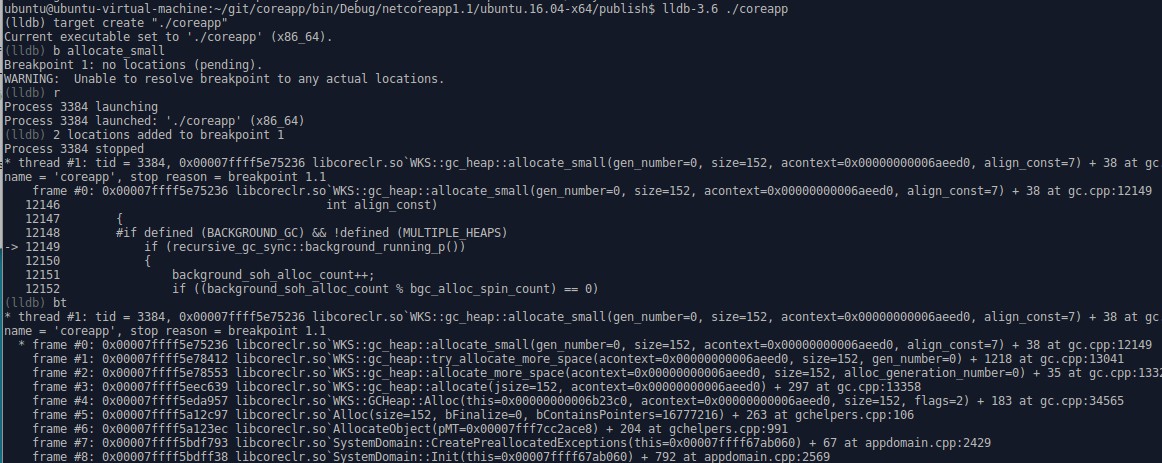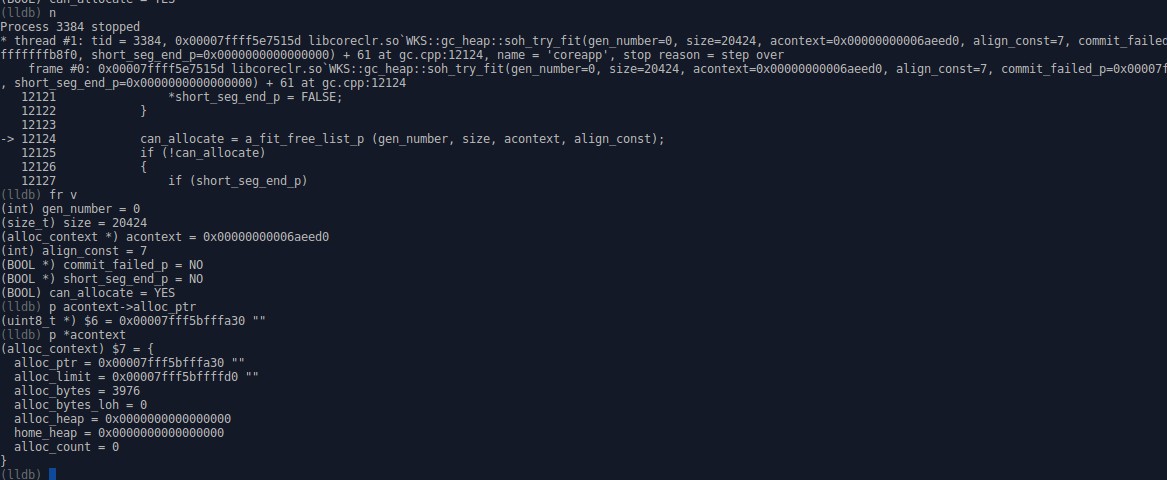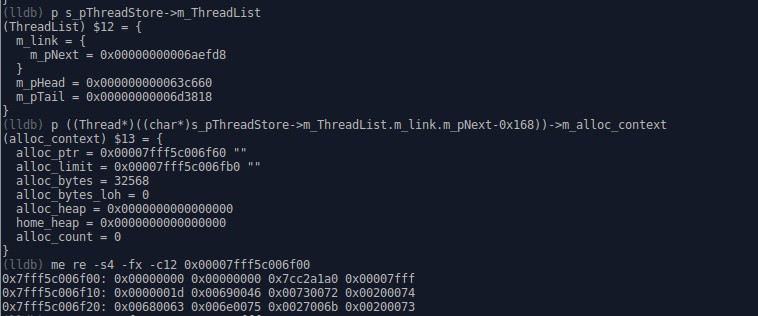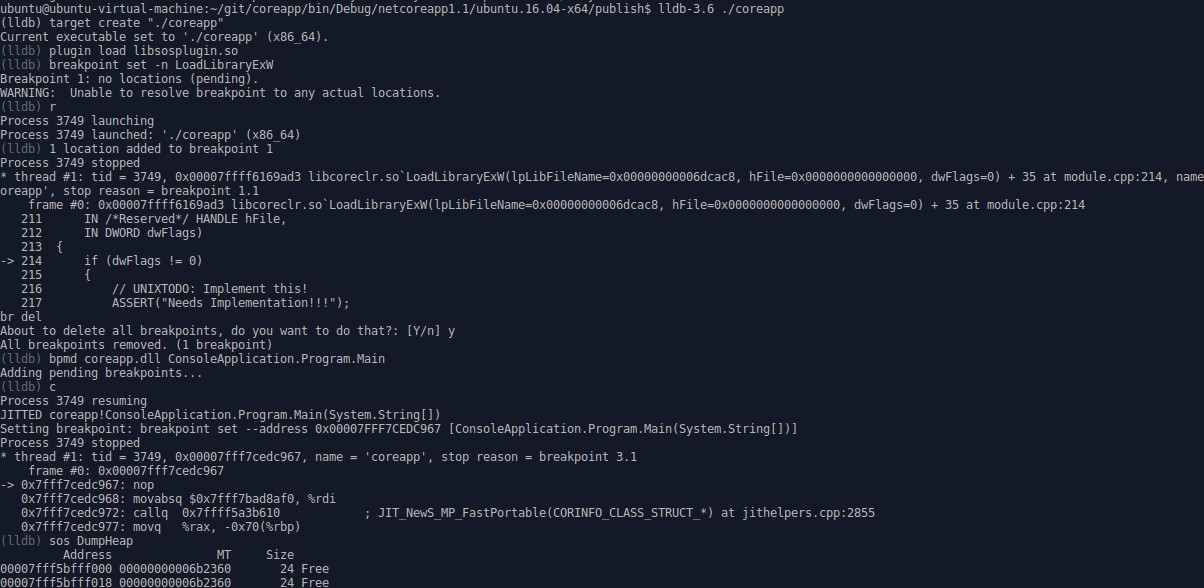CoreCLR源码探索(三) GC内存分配器的内部实现 (二)
a_fit_segment_end_p函数的内容: https://raw.githubusercontent.com/dotnet/coreclr/release/1.1.0/src/gc/gc.cpp
这个函数会尝试在堆段的结尾找到一块足够大小的空间, 如果找到则把分配上下文指向这个空间
BOOL gc_heap::a_fit_segment_end_p (int gen_number,
heap_segment* seg,
size_t size,
alloc_context* acontext,
int align_const,
BOOL* commit_failed_p)
{
*commit_failed_p = FALSE;
size_t limit = 0;
#ifdef BACKGROUND_GC
int cookie = -1;
#endif //BACKGROUND_GC
// 开始分配的地址
uint8_t*& allocated = ((gen_number == 0) ?
alloc_allocated :
heap_segment_allocated(seg));
size_t pad = Align (min_obj_size, align_const);
#ifdef FEATURE_LOH_COMPACTION
if (gen_number == (max_generation + 1))
{
pad += Align (loh_padding_obj_size, align_const);
}
#endif //FEATURE_LOH_COMPACTION
// 最多能分配到的地址 = 已提交到物理内存的地址 - 对齐大小
uint8_t* end = heap_segment_committed (seg) - pad;
// 如果空间足够则跳到found_fit
if (a_size_fit_p (size, allocated, end, align_const))
{
limit = limit_from_size (size,
(end - allocated),
gen_number, align_const);
goto found_fit;
}
// 已提交到物理内存的地址不够用, 需要提交新的地址
// 最多能分配到的地址 = 堆段预留的末尾地址 - 对齐大小
end = heap_segment_reserved (seg) - pad;
// 如果空间足够则调用grow_heap_segment
// 调用grow_heap_segment成功则跳到found_fit, 否则设置commit_failed_p的值等于true
if (a_size_fit_p (size, allocated, end, align_const))
{
limit = limit_from_size (size,
(end - allocated),
gen_number, align_const);
if (grow_heap_segment (seg, allocated + limit))
{
goto found_fit;
}
else
{
dprintf (2, ("can't grow segment, doing a full gc"));
*commit_failed_p = TRUE;
}
}
goto found_no_fit;
found_fit:
// 如果启用了后台GC, 并且正在分配大对象, 需要检测后台GC是否正在标记对象
#ifdef BACKGROUND_GC
if (gen_number != 0)
{
cookie = bgc_alloc_lock->loh_alloc_set (allocated);
}
#endif //BACKGROUND_GC
uint8_t* old_alloc;
old_alloc = allocated;
// 如果是第3代(大对象)则往对齐的空间添加一个自由对象
#ifdef FEATURE_LOH_COMPACTION
if (gen_number == (max_generation + 1))
{
size_t loh_pad = Align (loh_padding_obj_size, align_const);
make_unused_array (old_alloc, loh_pad);
old_alloc += loh_pad;
allocated += loh_pad;
limit -= loh_pad;
}
#endif //FEATURE_LOH_COMPACTION
// 清空SyncBlock
// 正常不需要, 因为前一个对象已经清零并预留好空间
#if defined (VERIFY_HEAP) && defined (_DEBUG)
((void**) allocated)[-1] = 0; //clear the sync block
#endif //VERIFY_HEAP && _DEBUG
// 增加开始分配的地址, 下一次将会从这里分配
// 注意这个不是本地变量而是引用
allocated += limit;
dprintf (3, ("found fit at end of seg: %Ix", old_alloc));
#ifdef BACKGROUND_GC
if (cookie != -1)
{
// 如果后台GC正在标记对象需要调用bgc_loh_alloc_clr给分配上下文设置新的范围
// 这个函数会在下一节(分配大对象内存的代码流程)解释
bgc_loh_alloc_clr (old_alloc, limit, acontext, align_const, cookie, TRUE, seg);
}
else
#endif //BACKGROUND_GC
{
// 给分配上下文设置新的范围
adjust_limit_clr (old_alloc, limit, acontext, seg, align_const, gen_number);
}
return TRUE;
found_no_fit:
return FALSE;
}
adjust_limit_clr函数的内容: https://raw.githubusercontent.com/dotnet/coreclr/release/1.1.0/src/gc/gc.cpp
这个函数会给分配上下文设置新的范围
不管是从自由列表还是堆段的结尾分配都会调用这个函数, 从自由列表分配时seg参数会是nullptr
调用完这个函数以后分配上下文就有足够的空间了, 回到gc_heap::allocate的retry就可以成功的分配到对象的内存
void gc_heap::adjust_limit_clr (uint8_t* start, size_t limit_size,
alloc_context* acontext, heap_segment* seg,
int align_const, int gen_number)
{
size_t aligned_min_obj_size = Align(min_obj_size, align_const);
//probably should pass seg==0 for free lists.
if (seg)
{
assert (heap_segment_used (seg) <= heap_segment_committed (seg));
}
dprintf (3, ("Expanding segment allocation [%Ix, %Ix[", (size_t)start,
(size_t)start + limit_size - aligned_min_obj_size));
// 如果分配上下文的开始地址改变了, 并且原来的空间未用完(只是不够用), 应该在这个空间创建一个自由对象
// 这里就是BOTR中说的如果剩下30bytes但是要分配40bytes时会在原来的30bytes创建一个自由对象
// 但如果只是结束地址改变了, 开始地址未改变则不需要
if ((acontext->alloc_limit != start) &&
(acontext->alloc_limit + aligned_min_obj_size)!= start)
{
uint8_t* hole = acontext->alloc_ptr;
if (hole != 0)
{
size_t size = (acontext->alloc_limit - acontext->alloc_ptr);
dprintf (3, ("filling up hole [%Ix, %Ix[", (size_t)hole, (size_t)hole + size + Align (min_obj_size, align_const)));
// when we are finishing an allocation from a free list
// we know that the free area was Align(min_obj_size) larger
acontext->alloc_bytes -= size;
size_t free_obj_size = size + aligned_min_obj_size;
make_unused_array (hole, free_obj_size);
generation_free_obj_space (generation_of (gen_number)) += free_obj_size;
}
// 设置新的开始地址
acontext->alloc_ptr = start;
}
// 设置新的结束地址
acontext->alloc_limit = (start + limit_size - aligned_min_obj_size);
// 添加已分配的字节数
acontext->alloc_bytes += limit_size - ((gen_number < max_generation + 1) ? aligned_min_obj_size : 0);
#ifdef FEATURE_APPDOMAIN_RESOURCE_MONITORING
if (g_fEnableARM)
{
AppDomain* alloc_appdomain = GetAppDomain();
alloc_appdomain->RecordAllocBytes (limit_size, heap_number);
}
#endif //FEATURE_APPDOMAIN_RESOURCE_MONITORING
uint8_t* saved_used = 0;
if (seg)
{
saved_used = heap_segment_used (seg);
}
// 如果传入了seg参数, 调整heap_segment::used的位置
if (seg == ephemeral_heap_segment)
{
//Sometimes the allocated size is advanced without clearing the
//memory. Let's catch up here
if (heap_segment_used (seg) < (alloc_allocated - plug_skew))
{
#ifdef MARK_ARRAY
#ifndef BACKGROUND_GC
clear_mark_array (heap_segment_used (seg) + plug_skew, alloc_allocated);
#endif //BACKGROUND_GC
#endif //MARK_ARRAY
heap_segment_used (seg) = alloc_allocated - plug_skew;
}
}
#ifdef BACKGROUND_GC
else if (seg)
{
uint8_t* old_allocated = heap_segment_allocated (seg) - plug_skew - limit_size;
#ifdef FEATURE_LOH_COMPACTION
old_allocated -= Align (loh_padding_obj_size, align_const);
#endif //FEATURE_LOH_COMPACTION
assert (heap_segment_used (seg) >= old_allocated);
}
#endif //BACKGROUND_GC
// 对设置的空间进行清0
// plug_skew其实就是SyncBlock的大小, 这里会把start前面的一个SyncBlock也清0
// 对大块内存的清0会比较耗费时间, 清0之前会释放掉MSL锁
if ((seg == 0) ||
(start - plug_skew + limit_size) <= heap_segment_used (seg))
{
dprintf (SPINLOCK_LOG, ("[%d]Lmsl to clear memory(1)", heap_number));
add_saved_spinlock_info (me_release, mt_clr_mem);
leave_spin_lock (&more_space_lock);
dprintf (3, ("clearing memory at %Ix for %d bytes", (start - plug_skew), limit_size));
memclr (start - plug_skew, limit_size);
}
else
{
uint8_t* used = heap_segment_used (seg);
heap_segment_used (seg) = start + limit_size - plug_skew;
dprintf (SPINLOCK_LOG, ("[%d]Lmsl to clear memory", heap_number));
add_saved_spinlock_info (me_release, mt_clr_mem);
leave_spin_lock (&more_space_lock);
if ((start - plug_skew) < used)
{
if (used != saved_used)
{
FATAL_GC_ERROR ();
}
dprintf (2, ("clearing memory before used at %Ix for %Id bytes",
(start - plug_skew), (plug_skew + used - start)));
memclr (start - plug_skew, used - (start - plug_skew));
}
}
// 设置BrickTable
// BrickTable中属于start的块会设置为alloc_ptr距离块开始地址的大小
// 之后一直到start + limit的块会设置为-1
//this portion can be done after we release the lock
if (seg == ephemeral_heap_segment)
{
#ifdef FFIND_OBJECT
if (gen0_must_clear_bricks > 0)
{
//set the brick table to speed up find_object
size_t b = brick_of (acontext->alloc_ptr);
set_brick (b, acontext->alloc_ptr - brick_address (b));
b++;
dprintf (3, ("Allocation Clearing bricks [%Ix, %Ix[",
b, brick_of (align_on_brick (start + limit_size))));
volatile short* x = &brick_table [b];
short* end_x = &brick_table [brick_of (align_on_brick (start + limit_size))];
for (;x < end_x;x++)
*x = -1;
}
else
#endif //FFIND_OBJECT
{
gen0_bricks_cleared = FALSE;
}
}
// verifying the memory is completely cleared.
//verify_mem_cleared (start - plug_skew, limit_size);
}
总结小对象内存的代码流程
- allocate: 尝试从分配上下文分配内存, 失败时调用allocate_more_space为分配上下文指定新的空间
- allocate_more_space: 调用try_allocate_more_space函数
- try_allocate_more_space: 检查是否有必要触发GC, 然后根据gen_number参数调用allocate_small或allocate_large函数
- allocate_small: 循环尝试进行各种回收内存的处理和调用soh_try_fit函数
- soh_try_fit: 先尝试调用a_fit_free_list_p从自由对象列表中分配, 然后尝试调用a_fit_segment_end_p从堆段结尾分配
- a_fit_free_list_p: 尝试从自由对象列表中找到足够大小的空间, 如果找到则把分配上下文指向这个空间
- adjust_limit_clr: 给分配上下文设置新的范围
- a_fit_segment_end_p: 尝试在堆段的结尾找到一块足够大小的空间, 如果找到则把分配上下文指向这个空间
- adjust_limit_clr: 给分配上下文设置新的范围
- a_fit_free_list_p: 尝试从自由对象列表中找到足够大小的空间, 如果找到则把分配上下文指向这个空间
- soh_try_fit: 先尝试调用a_fit_free_list_p从自由对象列表中分配, 然后尝试调用a_fit_segment_end_p从堆段结尾分配
- allocate_small: 循环尝试进行各种回收内存的处理和调用soh_try_fit函数
- try_allocate_more_space: 检查是否有必要触发GC, 然后根据gen_number参数调用allocate_small或allocate_large函数
- allocate_more_space: 调用try_allocate_more_space函数
分配大对象内存的代码流程
让我们来看一下大对象的内存是如何分配的
分配小对象我们从gc_heap::allocate开始跟踪, 这里我们从gc_heap::allocate_large_object开始跟踪
allocate_large_object函数的内容: https://raw.githubusercontent.com/dotnet/coreclr/release/1.1.0/src/gc/gc.cpp
这个函数和allocate函数不同的是它不会尝试从分配上下文中分配, 而是直接从堆段中分配
CObjectHeader* gc_heap::allocate_large_object (size_t jsize, int64_t& alloc_bytes)
{
// 创建一个空的分配上下文
//create a new alloc context because gen3context is shared.
alloc_context acontext;
acontext.alloc_ptr = 0;
acontext.alloc_limit = 0;
acontext.alloc_bytes = 0;
#ifdef MULTIPLE_HEAPS
acontext.alloc_heap = vm_heap;
#endif //MULTIPLE_HEAPS
#ifdef MARK_ARRAY
uint8_t* current_lowest_address = lowest_address;
uint8_t* current_highest_address = highest_address;
#ifdef BACKGROUND_GC
if (recursive_gc_sync::background_running_p())
{
current_lowest_address = background_saved_lowest_address;
current_highest_address = background_saved_highest_address;
}
#endif //BACKGROUND_GC
#endif // MARK_ARRAY
// 检查对象大小是否超过了最大允许的对象大小
// 超过时分配失败
size_t maxObjectSize = (INT32_MAX - 7 - Align(min_obj_size));
#ifdef BIT64
if (g_pConfig->GetGCAllowVeryLargeObjects())
{
maxObjectSize = (INT64_MAX - 7 - Align(min_obj_size));
}
#endif
if (jsize >= maxObjectSize)
{
if (g_pConfig->IsGCBreakOnOOMEnabled())
{
GCToOSInterface::DebugBreak();
}
#ifndef FEATURE_REDHAWK
ThrowOutOfMemoryDimensionsExceeded();
#else
return 0;
#endif
}
// 计算对齐
size_t size = AlignQword (jsize);
int align_const = get_alignment_constant (FALSE);
#ifdef FEATURE_LOH_COMPACTION
size_t pad = Align (loh_padding_obj_size, align_const);
#else
size_t pad = 0;
#endif //FEATURE_LOH_COMPACTION
// 调用allocate_more_space函数
// 因为分配上下文是空的, 这里我们给分配上下文指定的空间就是这个大对象使用的空间
assert (size >= Align (min_obj_size, align_const));
#ifdef _MSC_VER
#pragma inline_depth(0)
#endif //_MSC_VER
if (! allocate_more_space (&acontext, (size + pad), max_generation+1))
{
return 0;
}
#ifdef _MSC_VER
#pragma inline_depth(20)
#endif //_MSC_VER
#ifdef FEATURE_LOH_COMPACTION
// The GC allocator made a free object already in this alloc context and
// adjusted the alloc_ptr accordingly.
#endif //FEATURE_LOH_COMPACTION
// 对象分配到刚才获取到的空间的开始地址
uint8_t* result = acontext.alloc_ptr;
// 空间大小应该等于对象大小
assert ((size_t)(acontext.alloc_limit - acontext.alloc_ptr) == size);
// 返回结果
CObjectHeader* obj = (CObjectHeader*)result;
#ifdef MARK_ARRAY
if (recursive_gc_sync::background_running_p())
{
// 如果对象不在扫描范围中清掉标记的bit
if ((result < current_highest_address) && (result >= current_lowest_address))
{
dprintf (3, ("Clearing mark bit at address %Ix",
(size_t)(&mark_array [mark_word_of (result)])));
mark_array_clear_marked (result);
}
#ifdef BACKGROUND_GC
//the object has to cover one full mark uint32_t
assert (size > mark_word_size);
if (current_c_gc_state == c_gc_state_marking)
{
dprintf (3, ("Concurrent allocation of a large object %Ix",
(size_t)obj));
// 如果对象在扫描范围中则设置标记bit防止它被回收
//mark the new block specially so we know it is a new object
if ((result < current_highest_address) && (result >= current_lowest_address))
{
dprintf (3, ("Setting mark bit at address %Ix",
(size_t)(&mark_array [mark_word_of (result)])));
mark_array_set_marked (result);
}
}
#endif //BACKGROUND_GC
}
#endif //MARK_ARRAY
assert (obj != 0);
assert ((size_t)obj == Align ((size_t)obj, align_const));
alloc_bytes += acontext.alloc_bytes;
return obj;
}
allocate_more_space这个函数我们在之前已经看过了, 忘掉的可以向前翻
这个函数会调用try_allocate_more_space函数
try_allocate_more_space函数在分配大对象时会调用allocate_large函数
allocate_large函数的内容: https://raw.githubusercontent.com/dotnet/coreclr/release/1.1.0/src/gc/gc.cpp
这个函数的结构和alloc_small相似但是内部处理的细节不一样
BOOL gc_heap::allocate_large (int gen_number,
size_t size,
alloc_context* acontext,
int align_const)
{
// 后台GC运行时且不在计划阶段
// 原来是16次处理1次但是现在if被注释了
#ifdef BACKGROUND_GC
if (recursive_gc_sync::background_running_p() && (current_c_gc_state != c_gc_state_planning))
{
background_loh_alloc_count++;
//if ((background_loh_alloc_count % bgc_alloc_spin_count_loh) == 0)
{
// 如果合适在后台GC完成前分配对象
if (bgc_loh_should_allocate())
{
// 如果记录的LOH(Large Object Heap)增长比较大则这个线程需要暂停一下, 先安排其他线程工作
// 释放MSL锁并调用YieldThread, 如果switchCount参数(bgc_alloc_spin_loh)较大还有可能休眠1ms
if (!bgc_alloc_spin_loh)
{
Thread* current_thread = GetThread();
add_saved_spinlock_info (me_release, mt_alloc_large);
dprintf (SPINLOCK_LOG, ("[%d]spin Lmsl loh", heap_number));
leave_spin_lock (&more_space_lock);
BOOL cooperative_mode = enable_preemptive (current_thread);
GCToOSInterface::YieldThread (bgc_alloc_spin_loh);
disable_preemptive (current_thread, cooperative_mode);
enter_spin_lock (&more_space_lock);
add_saved_spinlock_info (me_acquire, mt_alloc_large);
dprintf (SPINLOCK_LOG, ("[%d]spin Emsl loh", heap_number));
}
}
// 不合适时等待后台GC完成
else
{
wait_for_background (awr_loh_alloc_during_bgc);
}
}
}
#endif //BACKGROUND_GC
gc_reason gr = reason_oos_loh;
generation* gen = generation_of (gen_number);
oom_reason oom_r = oom_no_failure;
size_t current_full_compact_gc_count = 0;
// No variable values should be "carried over" from one state to the other.
// That's why there are local variable for each state
allocation_state loh_alloc_state = a_state_start;
#ifdef RECORD_LOH_STATE
EEThreadId current_thread_id;
current_thread_id.SetToCurrentThread();
#endif //RECORD_LOH_STATE
// 开始循环切换状态, 请关注loh_alloc_state
// If we can get a new seg it means allocation will succeed.
while (1)
{
dprintf (3, ("[h%d]loh state is %s", heap_number, allocation_state_str[loh_alloc_state]));
#ifdef RECORD_LOH_STATE
add_saved_loh_state (loh_alloc_state, current_thread_id);
#endif //RECORD_LOH_STATE
switch (loh_alloc_state)
{
// 成功或失败时跳出循环
case a_state_can_allocate:
case a_state_cant_allocate:
{
goto exit;
}
// 开始时切换状态到a_state_try_fit
case a_state_start:
{
loh_alloc_state = a_state_try_fit;
break;
}
// 调用loh_try_fit函数
// 成功时切换状态到a_state_can_allocate
// 失败时切换状态到a_state_trigger_full_compact_gc或a_state_acquire_seg
case a_state_try_fit:
{
BOOL commit_failed_p = FALSE;
BOOL can_use_existing_p = FALSE;
can_use_existing_p = loh_try_fit (gen_number, size, acontext,
align_const, &commit_failed_p, &oom_r);
loh_alloc_state = (can_use_existing_p ?
a_state_can_allocate :
(commit_failed_p ?
a_state_trigger_full_compact_gc :
a_state_acquire_seg));
assert ((loh_alloc_state == a_state_can_allocate) == (acontext->alloc_ptr != 0));
break;
}
// 在创建了一个新的堆段以后调用loh_try_fit函数
// 成功时切换状态到a_state_can_allocate
// 失败时切换状态到a_state_try_fit
case a_state_try_fit_new_seg:
{
BOOL commit_failed_p = FALSE;
BOOL can_use_existing_p = FALSE;
can_use_existing_p = loh_try_fit (gen_number, size, acontext,
align_const, &commit_failed_p, &oom_r);
// 即使我们创建了一个新的堆段也不代表分配一定会成功,例如被其他线程抢走了,如果这样我们需要重试
// Even after we got a new seg it doesn't necessarily mean we can allocate,
// another LOH allocating thread could have beat us to acquire the msl so
// we need to try again.
loh_alloc_state = (can_use_existing_p ? a_state_can_allocate : a_state_try_fit);
assert ((loh_alloc_state == a_state_can_allocate) == (acontext->alloc_ptr != 0));
break;
}
// 在压缩GC后创建一个新的堆段成功, 调用loh_try_fit函数在这个堆段上分配
// 成功时切换状态到a_state_can_allocate
// 失败时如果提交到物理内存失败(物理内存不足)则切换状态到a_state_cant_allocate
// 否则再尝试一次创建一个新的堆段
case a_state_try_fit_new_seg_after_cg:
{
BOOL commit_failed_p = FALSE;
BOOL can_use_existing_p = FALSE;
can_use_existing_p = loh_try_fit (gen_number, size, acontext,
align_const, &commit_failed_p, &oom_r);
// Even after we got a new seg it doesn't necessarily mean we can allocate,
// another LOH allocating thread could have beat us to acquire the msl so
// we need to try again. However, if we failed to commit, which means we
// did have space on the seg, we bail right away 'cause we already did a
// full compacting GC.
loh_alloc_state = (can_use_existing_p ?
a_state_can_allocate :
(commit_failed_p ?
a_state_cant_allocate :
a_state_acquire_seg_after_cg));
assert ((loh_alloc_state == a_state_can_allocate) == (acontext->alloc_ptr != 0));
break;
}
// 这个状态目前不会被其他状态切换到
// 简单的调用loh_try_fit函数成功则切换到a_state_can_allocate失败则切换到a_state_cant_allocate
case a_state_try_fit_no_seg:
{
BOOL commit_failed_p = FALSE;
BOOL can_use_existing_p = FALSE;
can_use_existing_p = loh_try_fit (gen_number, size, acontext,
align_const, &commit_failed_p, &oom_r);
loh_alloc_state = (can_use_existing_p ? a_state_can_allocate : a_state_cant_allocate);
assert ((loh_alloc_state == a_state_can_allocate) == (acontext->alloc_ptr != 0));
assert ((loh_alloc_state != a_state_cant_allocate) || (oom_r != oom_no_failure));
break;
}
// 压缩GC完成后调用loh_try_fit函数
// 成功时切换状态到a_state_can_allocate
// 如果压缩后仍分配失败, 并且提交内存到物理内存失败(物理内存不足)则切换状态到a_state_cant_allocate
// 如果压缩后仍分配失败, 但是提交内存到物理内存并无失败则尝试再次创建一个新的堆段
case a_state_try_fit_after_cg:
{
BOOL commit_failed_p = FALSE;
BOOL can_use_existing_p = FALSE;
can_use_existing_p = loh_try_fit (gen_number, size, acontext,
align_const, &commit_failed_p, &oom_r);
loh_alloc_state = (can_use_existing_p ?
a_state_can_allocate :
(commit_failed_p ?
a_state_cant_allocate :
a_state_acquire_seg_after_cg));
assert ((loh_alloc_state == a_state_can_allocate) == (acontext->alloc_ptr != 0));
break;
}
// 在后台GC完成后调用loh_try_fit函数
// 成功时切换状态到a_state_can_allocate
// 如果提交内存到物理内存失败(物理内存不足)则切换状态到a_state_trigger_full_compact_gc
// 如果提交内存到物理内存并无失败则尝试创建一个新的堆段
case a_state_try_fit_after_bgc:
{
BOOL commit_failed_p = FALSE;
BOOL can_use_existing_p = FALSE;
can_use_existing_p = loh_try_fit (gen_number, size, acontext,
align_const, &commit_failed_p, &oom_r);
loh_alloc_state = (can_use_existing_p ?
a_state_can_allocate :
(commit_failed_p ?
a_state_trigger_full_compact_gc :
a_state_acquire_seg_after_bgc));
assert ((loh_alloc_state == a_state_can_allocate) == (acontext->alloc_ptr != 0));
break;
}
// 尝试创建一个新的堆段
// 成功时切换状态到a_state_try_fit_new_seg
// 失败时如果已执行了压缩则切换状态到a_state_check_retry_seg, 否则切换状态到a_state_check_and_wait_for_bgc
case a_state_acquire_seg:
{
BOOL can_get_new_seg_p = FALSE;
BOOL did_full_compacting_gc = FALSE;
current_full_compact_gc_count = get_full_compact_gc_count();
can_get_new_seg_p = loh_get_new_seg (gen, size, align_const, &did_full_compacting_gc, &oom_r);
loh_alloc_state = (can_get_new_seg_p ?
a_state_try_fit_new_seg :
(did_full_compacting_gc ?
a_state_check_retry_seg :
a_state_check_and_wait_for_bgc));
break;
}
// 尝试在压缩GC后创建一个新的堆段
// 成功时切换状态到a_state_try_fit_new_seg_after_cg
// 失败时切换状态到a_state_check_retry_seg
case a_state_acquire_seg_after_cg:
{
BOOL can_get_new_seg_p = FALSE;
BOOL did_full_compacting_gc = FALSE;
current_full_compact_gc_count = get_full_compact_gc_count();
can_get_new_seg_p = loh_get_new_seg (gen, size, align_const, &did_full_compacting_gc, &oom_r);
// Since we release the msl before we try to allocate a seg, other
// threads could have allocated a bunch of segments before us so
// we might need to retry.
loh_alloc_state = (can_get_new_seg_p ?
a_state_try_fit_new_seg_after_cg :
a_state_check_retry_seg);
break;
}
// 后台GC完成后尝试创建一个新的堆段
// 成功时切换状态到a_state_try_fit_new_seg
// 失败时如果已执行了压缩则切换状态到a_state_check_retry_seg, 否则切换状态到a_state_trigger_full_compact_gc
case a_state_acquire_seg_after_bgc:
{
BOOL can_get_new_seg_p = FALSE;
BOOL did_full_compacting_gc = FALSE;
current_full_compact_gc_count = get_full_compact_gc_count();
can_get_new_seg_p = loh_get_new_seg (gen, size, align_const, &did_full_compacting_gc, &oom_r);
loh_alloc_state = (can_get_new_seg_p ?
a_state_try_fit_new_seg :
(did_full_compacting_gc ?
a_state_check_retry_seg :
a_state_trigger_full_compact_gc));
assert ((loh_alloc_state != a_state_cant_allocate) || (oom_r != oom_no_failure));
break;
}
// 等待后台GC完成
// 如果后台GC不在运行状态中则切换状态到a_state_trigger_full_compact_gc
// 如果执行了压缩则切换状态到a_state_try_fit_after_cg, 否则切换状态到a_state_try_fit_after_bgc
case a_state_check_and_wait_for_bgc:
{
BOOL bgc_in_progress_p = FALSE;
BOOL did_full_compacting_gc = FALSE;
if (fgn_maxgen_percent)
{
dprintf (2, ("FGN: failed to acquire seg, may need to do a full blocking GC"));
send_full_gc_notification (max_generation, FALSE);
}
bgc_in_progress_p = check_and_wait_for_bgc (awr_loh_oos_bgc, &did_full_compacting_gc);
loh_alloc_state = (!bgc_in_progress_p ?
a_state_trigger_full_compact_gc :
(did_full_compacting_gc ?
a_state_try_fit_after_cg :
a_state_try_fit_after_bgc));
break;
}
// 触发第0和1和2代的压缩GC
// 成功时切换状态到a_state_try_fit_after_cg, 失败时切换状态到a_state_cant_allocate
case a_state_trigger_full_compact_gc:
{
BOOL got_full_compacting_gc = FALSE;
got_full_compacting_gc = trigger_full_compact_gc (gr, &oom_r);
loh_alloc_state = (got_full_compacting_gc ? a_state_try_fit_after_cg : a_state_cant_allocate);
assert ((loh_alloc_state != a_state_cant_allocate) || (oom_r != oom_no_failure));
break;
}
// 检查是否应该重试GC或申请新的堆段
// 应该重试GC时切换状态到a_state_trigger_full_compact_gc
// 应该重试申请新的堆段时切换状态到a_state_acquire_seg_after_cg
// 否则切换状态到a_state_cant_allocate
// 如果不能获取一个新的堆段, 但是对原来的堆段执行了压缩GC那就应该重试
case a_state_check_retry_seg:
{
BOOL should_retry_gc = retry_full_compact_gc (size);
BOOL should_retry_get_seg = FALSE;
if (!should_retry_gc)
{
size_t last_full_compact_gc_count = current_full_compact_gc_count;
current_full_compact_gc_count = get_full_compact_gc_count();
if (current_full_compact_gc_count > (last_full_compact_gc_count + 1))
{
should_retry_get_seg = TRUE;
}
}
loh_alloc_state = (should_retry_gc ?
a_state_trigger_full_compact_gc :
(should_retry_get_seg ?
a_state_acquire_seg_after_cg :
a_state_cant_allocate));
assert ((loh_alloc_state != a_state_cant_allocate) || (oom_r != oom_no_failure));
break;
}
default:
{
assert (!"Invalid state!");
break;
}
}
}
exit:
// 分配失败时处理OOM(Out Of Memory)
if (loh_alloc_state == a_state_cant_allocate)
{
assert (oom_r != oom_no_failure);
handle_oom (heap_number,
oom_r,
size,
0,
0);
add_saved_spinlock_info (me_release, mt_alloc_large_cant);
dprintf (SPINLOCK_LOG, ("[%d]Lmsl for loh oom", heap_number));
leave_spin_lock (&more_space_lock);
}
return (loh_alloc_state == a_state_can_allocate);
}
loh_try_fit函数的内容: https://raw.githubusercontent.com/dotnet/coreclr/release/1.1.0/src/gc/gc.cpp
处理和soh_try_fit差不多, 先尝试调用a_fit_free_list_large_p从自由对象列表中分配, 然后尝试调用loh_a_fit_segment_end_p从堆段结尾分配
BOOL gc_heap::loh_try_fit (int gen_number,
size_t size,
alloc_context* acontext,
int align_const,
BOOL* commit_failed_p,
oom_reason* oom_r)
{
BOOL can_allocate = TRUE;
// 尝试从自由对象列表分配
if (!a_fit_free_list_large_p (size, acontext, align_const))
{
// 尝试从堆段结尾分配
can_allocate = loh_a_fit_segment_end_p (gen_number, size,
acontext, align_const,
commit_failed_p, oom_r);
// 后台GC运行时, 统计在堆段结尾分配的大小
#ifdef BACKGROUND_GC
if (can_allocate && recursive_gc_sync::background_running_p())
{
bgc_loh_size_increased += size;
}
#endif //BACKGROUND_GC
}
#ifdef BACKGROUND_GC
else
{
// 后台GC运行时, 统计在自由对象列表分配的大小
if (recursive_gc_sync::background_running_p())
{
bgc_loh_allocated_in_free += size;
}
}
#endif //BACKGROUND_GC
return can_allocate;
}
a_fit_free_list_large_p函数的内容: https://raw.githubusercontent.com/dotnet/coreclr/release/1.1.0/src/gc/gc.cpp
和a_fit_free_list_p的处理基本相同, 但是在支持LOH压缩时会生成填充对象, 并且有可能会调用bgc_loh_alloc_clr函数
BOOL gc_heap::a_fit_free_list_large_p (size_t size,
alloc_context* acontext,
int align_const)
{
// 如果后台GC在计划阶段, 等待计划完成
#ifdef BACKGROUND_GC
wait_for_background_planning (awr_loh_alloc_during_plan);
#endif //BACKGROUND_GC
// 获取第3代的自由对象列表
BOOL can_fit = FALSE;
int gen_number = max_generation + 1;
generation* gen = generation_of (gen_number);
allocator* loh_allocator = generation_allocator (gen);
// 支持LOH压缩时需要在大对象前塞一个填充对象
#ifdef FEATURE_LOH_COMPACTION
size_t loh_pad = Align (loh_padding_obj_size, align_const);
#endif //FEATURE_LOH_COMPACTION
#ifdef BACKGROUND_GC
int cookie = -1;
#endif //BACKGROUND_GC
// 列表会按大小分为多个bucket(用链表形式链接)
// 大小会*2递增, 例如first_bucket的大小是256那第二个bucket的大小则为512
size_t sz_list = loh_allocator->first_bucket_size();
for (unsigned int a_l_idx = 0; a_l_idx < loh_allocator->number_of_buckets(); a_l_idx++)
{
if ((size < sz_list) || (a_l_idx == (loh_allocator->number_of_buckets()-1)))
{
uint8_t* free_list = loh_allocator->alloc_list_head_of (a_l_idx);
uint8_t* prev_free_item = 0;
while (free_list != 0)
{
dprintf (3, ("considering free list %Ix", (size_t)free_list));
size_t free_list_size = unused_array_size(free_list);
#ifdef FEATURE_LOH_COMPACTION
if ((size + loh_pad) <= free_list_size)
#else
if (((size + Align (min_obj_size, align_const)) <= free_list_size)||
(size == free_list_size))
#endif //FEATURE_LOH_COMPACTION
{
// 如果启用了后台GC, 并且正在分配大对象, 需要检测后台GC是否正在标记对象
#ifdef BACKGROUND_GC
cookie = bgc_alloc_lock->loh_alloc_set (free_list);
#endif //BACKGROUND_GC
// 大小足够时从该bucket的链表中pop出来
//unlink the free_item
loh_allocator->unlink_item (a_l_idx, free_list, prev_free_item, FALSE);
// Substract min obj size because limit_from_size adds it. Not needed for LOH
size_t limit = limit_from_size (size - Align(min_obj_size, align_const), free_list_size,
gen_number, align_const);
// 支持LOH压缩时需要在大对象前塞一个填充对象
#ifdef FEATURE_LOH_COMPACTION
make_unused_array (free_list, loh_pad);
limit -= loh_pad;
free_list += loh_pad;
free_list_size -= loh_pad;
#endif //FEATURE_LOH_COMPACTION
// 如果分配完还有剩余空间, 在剩余空间生成一个自由对象并塞回自由对象列表
uint8_t* remain = (free_list + limit);
size_t remain_size = (free_list_size - limit);
if (remain_size != 0)
{
assert (remain_size >= Align (min_obj_size, align_const));
make_unused_array (remain, remain_size);
}
if (remain_size >= Align(min_free_list, align_const))
{
loh_thread_gap_front (remain, remain_size, gen);
assert (remain_size >= Align (min_obj_size, align_const));
}
else
{
generation_free_obj_space (gen) += remain_size;
}
generation_free_list_space (gen) -= free_list_size;
dprintf (3, ("found fit on loh at %Ix", free_list));
#ifdef BACKGROUND_GC
if (cookie != -1)
{
// 如果后台GC正在标记对象需要调用bgc_loh_alloc_clr给分配上下文设置新的范围
bgc_loh_alloc_clr (free_list, limit, acontext, align_const, cookie, FALSE, 0);
}
else
#endif //BACKGROUND_GC
{
// 给分配上下文设置新的范围
adjust_limit_clr (free_list, limit, acontext, 0, align_const, gen_number);
}
//fix the limit to compensate for adjust_limit_clr making it too short
acontext->alloc_limit += Align (min_obj_size, align_const);
can_fit = TRUE;
goto exit;
}
// 同一bucket的下一个自由对象
prev_free_item = free_list;
free_list = free_list_slot (free_list);
}
}
// 当前bucket的大小不够, 下一个bucket的大小会是当前bucket的两倍
sz_list = sz_list * 2;
}
exit:
return can_fit;
}
adjust_limit_clr这个函数我们在看小对象的代码流程时已经看过
这里看bgc_loh_alloc_clr函数的内容: https://raw.githubusercontent.com/dotnet/coreclr/release/1.1.0/src/gc/gc.cpp
这个函数是在后台GC运行时分配大对象使用的, 需要照顾到运行中的后台GC
#ifdef BACKGROUND_GC
void gc_heap::bgc_loh_alloc_clr (uint8_t* alloc_start,
size_t size,
alloc_context* acontext,
int align_const,
int lock_index,
BOOL check_used_p,
heap_segment* seg)
{
// 一开始就在这片空间创建一个自由对象
// 因为等会要释放在bgc_alloc_lock中的锁再清0内存所以要先创建一个自由对象防止GC使用这块空间
// 这个自由对象在最后重新上锁后会被重置回空白的空间
make_unused_array (alloc_start, size);
#ifdef FEATURE_APPDOMAIN_RESOURCE_MONITORING
if (g_fEnableARM)
{
AppDomain* alloc_appdomain = GetAppDomain();
alloc_appdomain->RecordAllocBytes (size, heap_number);
}
#endif //FEATURE_APPDOMAIN_RESOURCE_MONITORING
size_t size_of_array_base = sizeof(ArrayBase);
// 释放cookie对应的锁 (设置数组中lock_index位置的值为0)
bgc_alloc_lock->loh_alloc_done_with_index (lock_index);
// 开始对内存进行清0
// 计算清0的的范围
// clear memory while not holding the lock.
size_t size_to_skip = size_of_array_base;
size_t size_to_clear = size - size_to_skip - plug_skew;
size_t saved_size_to_clear = size_to_clear;
if (check_used_p)
{
uint8_t* end = alloc_start + size - plug_skew;
uint8_t* used = heap_segment_used (seg);
if (used < end)
{
if ((alloc_start + size_to_skip) < used)
{
size_to_clear = used - (alloc_start + size_to_skip);
}
else
{
size_to_clear = 0;
}
// 调整heap_segment::used的位置
dprintf (2, ("bgc loh: setting used to %Ix", end));
heap_segment_used (seg) = end;
}
dprintf (2, ("bgc loh: used: %Ix, alloc: %Ix, end of alloc: %Ix, clear %Id bytes",
used, alloc_start, end, size_to_clear));
}
else
{
dprintf (2, ("bgc loh: [%Ix-[%Ix(%Id)", alloc_start, alloc_start+size, size));
}
#ifdef VERIFY_HEAP
// since we filled in 0xcc for free object when we verify heap,
// we need to make sure we clear those bytes.
if (g_pConfig->GetHeapVerifyLevel() & EEConfig::HEAPVERIFY_GC)
{
if (size_to_clear < saved_size_to_clear)
{
size_to_clear = saved_size_to_clear;
}
}
#endif //VERIFY_HEAP
// 释放MSL锁并清0内存
dprintf (SPINLOCK_LOG, ("[%d]Lmsl to clear large obj", heap_number));
add_saved_spinlock_info (me_release, mt_clr_large_mem);
leave_spin_lock (&more_space_lock);
memclr (alloc_start + size_to_skip, size_to_clear);
// 重新找一个锁锁上
// 这里的锁会在PublishObject时释放
bgc_alloc_lock->loh_alloc_set (alloc_start);
// 设置分配上下文指向的范围
acontext->alloc_ptr = alloc_start;
acontext->alloc_limit = (alloc_start + size - Align (min_obj_size, align_const));
// 把自由对象重新变回一块空白的空间
// need to clear the rest of the object before we hand it out.
clear_unused_array(alloc_start, size);
}
#endif //BACKGROUND_GC
loh_a_fit_segment_end_p函数的内容: https://raw.githubusercontent.com/dotnet/coreclr/release/1.1.0/src/gc/gc.cpp
这个函数会遍历第3代的堆段链表逐个调用a_fit_segment_end_p函数尝试分配
BOOL gc_heap::loh_a_fit_segment_end_p (int gen_number,
size_t size,
alloc_context* acontext,
int align_const,
BOOL* commit_failed_p,
oom_reason* oom_r)
{
*commit_failed_p = FALSE;
// 获取代中第一个堆段节点用于接下来的分配
heap_segment* seg = generation_allocation_segment (generation_of (gen_number));
BOOL can_allocate_p = FALSE;
while (seg)
{
// 调用a_fit_segment_end_p尝试在这个堆段的结尾分配
if (a_fit_segment_end_p (gen_number, seg, (size - Align (min_obj_size, align_const)),
acontext, align_const, commit_failed_p))
{
acontext->alloc_limit += Align (min_obj_size, align_const);
can_allocate_p = TRUE;
break;
}
else
{
if (*commit_failed_p)
{
// 如果堆段还有剩余空间但不能提交到物理内存, 则返回内存不足错误
*oom_r = oom_cant_commit;
break;
}
else
{
// 如果堆段已无剩余空间, 看链表中的下一个堆段
seg = heap_segment_next_rw (seg);
}
}
}
return can_allocate_p;
}
总结大对象内存的代码流程
- allocate_large_object: 调用allocate_more_space为一个空的分配上下文指定新的空间, 空间大小会等于对象的大小
- allocate_more_space: 调用try_allocate_more_space函数
- try_allocate_more_space: 检查是否有必要触发GC, 然后根据gen_number参数调用allocate_small或allocate_large函数
- allocate_large: 循环尝试进行各种回收内存的处理和调用soh_try_fit函数
- loh_try_fit: 先尝试调用a_fit_free_list_large_p从自由对象列表中分配, 然后尝试调用loh_a_fit_segment_end_p从堆段结尾分配
- a_fit_free_list_large_p: 尝试从自由对象列表中找到足够大小的空间, 如果找到则把分配上下文指向这个空间
- bgc_loh_alloc_clr: 给分配上下文设置新的范围, 照顾到后台GC
- adjust_limit_clr: 给分配上下文设置新的范围
- loh_a_fit_segment_end_p: 遍历第3代的堆段链表逐个调用a_fit_segment_end_p函数尝试分配
- a_fit_segment_end_p: 尝试在堆段的结尾找到一块足够大小的空间, 如果找到则把分配上下文指向这个空间
- bgc_loh_alloc_clr: 给分配上下文设置新的范围, 照顾到后台GC
- adjust_limit_clr: 给分配上下文设置新的范围
- a_fit_segment_end_p: 尝试在堆段的结尾找到一块足够大小的空间, 如果找到则把分配上下文指向这个空间
- a_fit_free_list_large_p: 尝试从自由对象列表中找到足够大小的空间, 如果找到则把分配上下文指向这个空间
- loh_try_fit: 先尝试调用a_fit_free_list_large_p从自由对象列表中分配, 然后尝试调用loh_a_fit_segment_end_p从堆段结尾分配
- allocate_large: 循环尝试进行各种回收内存的处理和调用soh_try_fit函数
- try_allocate_more_space: 检查是否有必要触发GC, 然后根据gen_number参数调用allocate_small或allocate_large函数
- allocate_more_space: 调用try_allocate_more_space函数
CoreCLR如何管理系统内存 (windows, linux)
看到这里我们应该知道分配上下文, 小对象, 大对象的内存都是来源于堆段, 那堆段的内存来源于哪里呢?
GC在程序启动时会创建默认的堆段, 调用流程是init_gc_heap => get_initial_segment => make_heap_segment
如果默认的堆段不够用会创建新的堆段
小对象的堆段会通过gc1 => plan_phase => soh_get_segment_to_expand => get_segment => make_heap_segment创建
大对象的堆段会通过allocate_large => loh_get_new_seg => get_large_segment => get_segment_for_loh => get_segment => make_heap_segment创建
默认的堆段会通过next_initial_memory分配内存, 这一块内存在程序启动时从reserve_initial_memory函数申请
reserve_initial_memory函数和make_heap_segment函数都会调用virtual_alloc函数
因为调用流程很长我这里就不一个个函数贴代码了, 有兴趣的可以自己去跟踪
virtual_alloc函数的调用流程是
virtual_alloc => GCToOSInterface::VirtualReserve => ClrVirtualAllocAligned => ClrVirtualAlloc =>
CExecutionEngine::ClrVirtualAlloc => EEVirtualAlloc => VirtualAlloc
如果是windows, VirtualAlloc就是同名的windows api
如果是linux或者macosx, 调用流程是VirtualAlloc => VIRTUALReserveMemory => ReserveVirtualMemory
ReserveVirtualMemory函数会调用mmap函数
ReserveVirtualMemory函数的内容: https://github.com/dotnet/coreclr/blob/release/1.1.0/src/pal/src/map/virtual.cpp#L894
static LPVOID ReserveVirtualMemory(
IN CPalThread *pthrCurrent, /* Currently executing thread */
IN LPVOID lpAddress, /* Region to reserve or commit */
IN SIZE_T dwSize) /* Size of Region */
{
UINT_PTR StartBoundary = (UINT_PTR)lpAddress;
SIZE_T MemSize = dwSize;
TRACE( "Reserving the memory now.\n");
// Most platforms will only commit memory if it is dirtied,
// so this should not consume too much swap space.
int mmapFlags = 0;
#if HAVE_VM_ALLOCATE
// Allocate with vm_allocate first, then map at the fixed address.
int result = vm_allocate(mach_task_self(),
&StartBoundary,
MemSize,
((LPVOID) StartBoundary != nullptr) ? FALSE : TRUE);
if (result != KERN_SUCCESS)
{
ERROR("vm_allocate failed to allocated the requested region!\n");
pthrCurrent->SetLastError(ERROR_INVALID_ADDRESS);
return nullptr;
}
mmapFlags |= MAP_FIXED;
#endif // HAVE_VM_ALLOCATE
mmapFlags |= MAP_ANON | MAP_PRIVATE;
LPVOID pRetVal = mmap((LPVOID) StartBoundary,
MemSize,
PROT_NONE,
mmapFlags,
-1 /* fd */,
0 /* offset */);
if (pRetVal == MAP_FAILED)
{
ERROR( "Failed due to insufficient memory.\n" );
#if HAVE_VM_ALLOCATE
vm_deallocate(mach_task_self(), StartBoundary, MemSize);
#endif // HAVE_VM_ALLOCATE
pthrCurrent->SetLastError(ERROR_NOT_ENOUGH_MEMORY);
return nullptr;
}
/* Check to see if the region is what we asked for. */
if (lpAddress != nullptr && StartBoundary != (UINT_PTR)pRetVal)
{
ERROR("We did not get the region we asked for from mmap!\n");
pthrCurrent->SetLastError(ERROR_INVALID_ADDRESS);
munmap(pRetVal, MemSize);
return nullptr;
}
#if MMAP_ANON_IGNORES_PROTECTION
if (mprotect(pRetVal, MemSize, PROT_NONE) != 0)
{
ERROR("mprotect failed to protect the region!\n");
pthrCurrent->SetLastError(ERROR_INVALID_ADDRESS);
munmap(pRetVal, MemSize);
return nullptr;
}
#endif // MMAP_ANON_IGNORES_PROTECTION
return pRetVal;
}
CoreCLR在从系统申请内存时会使用VirtualAlloc或mmap模拟的VirtualAlloc
申请后会得到一块尚未完全提交到物理内存的虚拟内存(注意保护模式是PROT_NONE, 表示该块内存不能读写执行, 内核无需设置它的PageTable)
如果你有兴趣可以看一下CoreCLR的虚拟内存占用, 工作站GC启动时就占了1G多, 服务器GC启动时就占用了20G
之后CoreCLR会根据使用慢慢的把使用的部分提交到物理内存, 流程是
GCToOSInterface::VirtualCommit => ClrVirtualAlloc => CExecutionEngine::ClrVirtualAlloc =>
EEVirtualAlloc => VirtualAlloc
如果是windows, VirtualAlloc是同名的windowsapi, 地址会被显式指定且页保护模式为可读写(PAGE_READWRITE)
如果是linux或者macosx, VirtualAlloc会调用VIRTUALCommitMemory, 且内部会调用mprotect来设置该页为可读写(PROT_READ|PROT_WRITE)
当GC回收了垃圾对象, 不再需要部分内存时会把内存还给系统, 例如回收小对象后的流程是
gc1 => decommit_ephemeral_segment_pages => decommit_heap_segment_pages => GCToOSInterface::VirtualDecommit
GCToOSInterface::VirtualDecommit的调用流程是
GCToOSInterface::VirtualDecommit => ClrVirtualFree => CExecutionEngine::ClrVirtualFree =>
EEVirtualFree => VirtualFree
如果是windows, VirtualFree是同名的windowsapi, 表示该部分虚拟内存已经不再使用内核可以重置它们的PageTable
如果是linux或者macosx, VirtualFree通过mprotect模拟, 设置该页的保护模式为PROT_NONE
VirtualFree函数的内容: https://github.com/dotnet/coreclr/blob/release/1.1.0/src/pal/src/map/virtual.cpp#L1291
BOOL
PALAPI
VirtualFree(
IN LPVOID lpAddress, /* Address of region. */
IN SIZE_T dwSize, /* Size of region. */
IN DWORD dwFreeType ) /* Operation type. */
{
BOOL bRetVal = TRUE;
CPalThread *pthrCurrent;
PERF_ENTRY(VirtualFree);
ENTRY("VirtualFree(lpAddress=%p, dwSize=%u, dwFreeType=%#x)\n",
lpAddress, dwSize, dwFreeType);
pthrCurrent = InternalGetCurrentThread();
InternalEnterCriticalSection(pthrCurrent, &virtual_critsec);
/* Sanity Checks. */
if ( !lpAddress )
{
ERROR( "lpAddress cannot be NULL. You must specify the base address of\
regions to be de-committed. \n" );
pthrCurrent->SetLastError( ERROR_INVALID_ADDRESS );
bRetVal = FALSE;
goto VirtualFreeExit;
}
if ( !( dwFreeType & MEM_RELEASE ) && !(dwFreeType & MEM_DECOMMIT ) )
{
ERROR( "dwFreeType must contain one of the following: \
MEM_RELEASE or MEM_DECOMMIT\n" );
pthrCurrent->SetLastError( ERROR_INVALID_PARAMETER );
bRetVal = FALSE;
goto VirtualFreeExit;
}
/* You cannot release and decommit in one call.*/
if ( dwFreeType & MEM_RELEASE && dwFreeType & MEM_DECOMMIT )
{
ERROR( "MEM_RELEASE cannot be combined with MEM_DECOMMIT.\n" );
bRetVal = FALSE;
goto VirtualFreeExit;
}
if ( dwFreeType & MEM_DECOMMIT )
{
UINT_PTR StartBoundary = 0;
SIZE_T MemSize = 0;
if ( dwSize == 0 )
{
ERROR( "dwSize cannot be 0. \n" );
pthrCurrent->SetLastError( ERROR_INVALID_PARAMETER );
bRetVal = FALSE;
goto VirtualFreeExit;
}
/*
* A two byte range straddling 2 pages caues both pages to be either
* released or decommitted. So round the dwSize up to the next page
* boundary and round the lpAddress down to the next page boundary.
*/
MemSize = (((UINT_PTR)(dwSize) + ((UINT_PTR)(lpAddress) & VIRTUAL_PAGE_MASK)
+ VIRTUAL_PAGE_MASK) & ~VIRTUAL_PAGE_MASK);
StartBoundary = (UINT_PTR)lpAddress & ~VIRTUAL_PAGE_MASK;
PCMI pUnCommittedMem;
pUnCommittedMem = VIRTUALFindRegionInformation( StartBoundary );
if (!pUnCommittedMem)
{
ASSERT( "Unable to locate the region information.\n" );
pthrCurrent->SetLastError( ERROR_INTERNAL_ERROR );
bRetVal = FALSE;
goto VirtualFreeExit;
}
TRACE( "Un-committing the following page(s) %d to %d.\n",
StartBoundary, MemSize );
// Explicitly calling mmap instead of mprotect here makes it
// that much more clear to the operating system that we no
// longer need these pages.
if ( mmap( (LPVOID)StartBoundary, MemSize, PROT_NONE,
MAP_FIXED | MAP_ANON | MAP_PRIVATE, -1, 0 ) != MAP_FAILED )
{
#if (MMAP_ANON_IGNORES_PROTECTION)
if (mprotect((LPVOID) StartBoundary, MemSize, PROT_NONE) != 0)
{
ASSERT("mprotect failed to protect the region!\n");
pthrCurrent->SetLastError(ERROR_INTERNAL_ERROR);
munmap((LPVOID) StartBoundary, MemSize);
bRetVal = FALSE;
goto VirtualFreeExit;
}
#endif // MMAP_ANON_IGNORES_PROTECTION
SIZE_T index = 0;
SIZE_T nNumOfPagesToChange = 0;
/* We can now commit this memory by calling VirtualAlloc().*/
index = (StartBoundary - pUnCommittedMem->startBoundary) / VIRTUAL_PAGE_SIZE;
nNumOfPagesToChange = MemSize / VIRTUAL_PAGE_SIZE;
VIRTUALSetAllocState( MEM_RESERVE, index,
nNumOfPagesToChange, pUnCommittedMem );
goto VirtualFreeExit;
}
else
{
ASSERT( "mmap() returned an abnormal value.\n" );
bRetVal = FALSE;
pthrCurrent->SetLastError( ERROR_INTERNAL_ERROR );
goto VirtualFreeExit;
}
}
if ( dwFreeType & MEM_RELEASE )
{
PCMI pMemoryToBeReleased =
VIRTUALFindRegionInformation( (UINT_PTR)lpAddress );
if ( !pMemoryToBeReleased )
{
ERROR( "lpAddress must be the base address returned by VirtualAlloc.\n" );
pthrCurrent->SetLastError( ERROR_INVALID_ADDRESS );
bRetVal = FALSE;
goto VirtualFreeExit;
}
if ( dwSize != 0 )
{
ERROR( "dwSize must be 0 if you are releasing the memory.\n" );
pthrCurrent->SetLastError( ERROR_INVALID_PARAMETER );
bRetVal = FALSE;
goto VirtualFreeExit;
}
TRACE( "Releasing the following memory %d to %d.\n",
pMemoryToBeReleased->startBoundary, pMemoryToBeReleased->memSize );
if ( munmap( (LPVOID)pMemoryToBeReleased->startBoundary,
pMemoryToBeReleased->memSize ) == 0 )
{
if ( VIRTUALReleaseMemory( pMemoryToBeReleased ) == FALSE )
{
ASSERT( "Unable to remove the PCMI entry from the list.\n" );
pthrCurrent->SetLastError( ERROR_INTERNAL_ERROR );
bRetVal = FALSE;
goto VirtualFreeExit;
}
pMemoryToBeReleased = NULL;
}
else
{
ASSERT( "Unable to unmap the memory, munmap() returned an abnormal value.\n" );
pthrCurrent->SetLastError( ERROR_INTERNAL_ERROR );
bRetVal = FALSE;
goto VirtualFreeExit;
}
}
VirtualFreeExit:
LogVaOperation(
(dwFreeType & MEM_DECOMMIT) ? VirtualMemoryLogging::VirtualOperation::Decommit
: VirtualMemoryLogging::VirtualOperation::Release,
lpAddress,
dwSize,
dwFreeType,
0,
NULL,
bRetVal);
InternalLeaveCriticalSection(pthrCurrent, &virtual_critsec);
LOGEXIT( "VirtualFree returning %s.\n", bRetVal == TRUE ? "TRUE" : "FALSE" );
PERF_EXIT(VirtualFree);
return bRetVal;
}
我们可以看出, CoreCLR管理系统内存的方式比较底层
在windows上使用了VirtualAlloc和VirtualFree
在linux上使用了mmap和mprotect
而不是使用传统的malloc和new
这样会带来更好的性能但同时增加了移植到其他平台的成本
动态调试GC分配对象内存的过程
要深入学习CoreCLR光看代码是很难做到的, 比如这次大部分来源的gc.cpp有接近37000行的代码,
为了很好的了解CoreCLR的工作原理这次我自己编译了CoreCLR并在本地用lldb进行了调试, 这里我分享一下编译和调试的过程
这里我使用了ubuntu 16.04 LTS, 因为linux上部署编译环境比windows要简单很多
下载CORECLR:
git clone https://github.com/dotnet/coreclr.git
切换到你正在使用的版本, 请务必切换不要直接去编译master分支
git checkout v1.1.0
参考微软的帮助安装好需要的包
# https://github.com/dotnet/coreclr/blob/master/Documentation/building/linux-instructions.md
echo "deb http://llvm.org/apt/trusty/ llvm-toolchain-trusty-3.6 main" | sudo tee /etc/apt/sources.list.d/llvm.list
wget -O - http://llvm.org/apt/llvm-snapshot.gpg.key | sudo apt-key add -
sudo apt-get update
sudo apt-get install cmake llvm-3.5 clang-3.5 lldb-3.6 lldb-3.6-dev libunwind8 libunwind8-dev gettext libicu-dev liblttng-ust-dev libcurl4-openssl-dev libssl-dev uuid-dev
cd coreclr
./build.sh
执行build.sh会从微软的网站下载一些东西, 如果很长时间都下载不成功你应该考虑挂点什么东西
编译过程需要几十分钟, 完成以后可以在coreclr/bin/Product/Linux.x64.Debug下看到编译结果
完成以后用dotnet创建一个新的可执行项目, 在project.json中添加runtimes节
{
"runtimes": {
"ubuntu.16.04-x64": {}
}
}
Program.cs的代码可以随意写, 想测哪部分就写哪部分的代码,我这里写的是多线程分配内存然后释放的代码
using System;
using System.Threading;
using System.Collections.Generic;
namespace ConsoleApplication
{
public class A
{
public int a;
public byte[] padding;
}
public class Program
{
public static void ThreadBody()
{
Thread.Sleep(1000);
var list = new List<A>();
for (long x = 0; x < 1000000; ++x) {
list.Add(new A());
}
}
public static void Main(string[] args)
{
var threads = new List<Thread>();
for (var x = 0; x < 100; ++x)
{
var thread = new Thread(ThreadBody);
threads.Add(thread);
thread.Start();
}
foreach (var thread in threads)
{
thread.Join();
}
GC.Collect();
Console.WriteLine("memory released");
Console.ReadLine();
}
}
}
写完以后编译并发布
dotnet restore
dotnet publish
发布后bin/Debug/netcoreapp1.1/ubuntu16.04-x64/publish会多出最终发布的文件
把刚才CoreCLR编译出来的coreclr/bin/Product/Linux.x64.Debug下的所有文件复制到publish目录下, 并覆盖原有文件
微软官方的调试文档可见 https://github.com/dotnet/coreclr/blob/release/1.1.0/Documentation/building/debugging-instructions.md
使用lldb启动进程, 这里我项目名称是coreapp所以publish下的可执行文件名称也是coreapp
lldb-3.6 ./coreapp
启动进程后可以打命令来调试, 需要中断(暂停)程序运行可以按下ctrl+c
这张图中的命令
b allocate_small
给函数下断点, 这里的allocate_small虽然全名是SVR::gc_heap::allocate_small或WKS::gc_heap::allocate_small
但是lldb允许用短名称下断点, 碰到多个符合的函数会一并截取
r
运行程序, 之前在pending中的断点如果在程序运行后可以确定内存位置则实际的添加断点
bt
查看当前的堆栈调用树, 可以看当前被调用的函数的来源是哪些函数

这张图中的命令
n
步过, 遇到函数不会进去, 如果需要步进可以用s
另外步过汇编和步进汇编是ni和si
fr v
查看当前堆栈帧中的变量
也就是传入的参数和本地变量
p acontext->alloc_ptr
p *acontext
打印全局或本地变量的值, 这个命令是调试中必用的命令, 不仅支持查看变量还支持计算表达式

这张图中的命令
c
继续中断进程直到退出或下一个断点
br del
删除之前设置的所有断点

这张图显示的是线程列表中的第一个线程的分配上下文内容, 0x168可以通过p &((Thread*)nullptr)->m_Link计算得出(就是offsetof)
这张图中的命令
me re -s4 -fx -c12 0x00007fff5c006f00
读取0x00007fff5c006f00开始的内存, 单位是4byte, 表现形式是hex, 显示12个单位

lldb不仅能调试CoreCLR自身的代码
还能用来调试用户写的程序代码, 需要微软的SOS插件支持
详细可以看微软的官方文档 https://github.com/dotnet/coreclr/blob/release/1.1.0/Documentation/building/debugging-instructions.md
最后附上在这次分析中我常用的lldb命令
学习lldb可以查看官方的Tutorial和GDB and LLDB command examples
plugin load libsosplugin.so
process launch -s
process handle -s false SIGUSR1 SIGUSR2
breakpoint set -n LoadLibraryExW
c
sos DumpHeap
bpmd coreapp.dll ConsoleApplication.Program.Main
p g_pGCHeap
p n_heaps
p g_heaps[0]
p *WKS::gc_heap::ephemeral_heap_segment
p g_heaps[0]->ephemeral_heap_segment
p s_pThreadStore->m_ThreadList
p &((Thread*)nullptr)->m_Link
p ((Thread*)((char*)s_pThreadStore->m_ThreadList.m_link.m_pNext-0x168))->m_alloc_context
p ((Thread*)((char*)s_pThreadStore->m_ThreadList.m_link.m_pNext->m_pNext-0x168))->m_alloc_context
me re -s4 -fx -c100 0x00007fff5c027fe0
p generation_table
p generation_table[0]
p generation_table[2].free_list_allocator
p generation_table[2].free_list_allocator.first_bucket.head
p (generation_table[2].free_list_allocator.buckets)->head
p (generation_table[2].free_list_allocator.buckets+1)->head
p *generation_table[2].free_list_allocator.buckets
wa s v generation_table[2].free_list_allocator.first_bucket.head
me re -s8 -fx -c3 0x00007fff5bfff018如果您发现该资源为电子书等存在侵权的资源或对该资源描述不正确等,可点击“私信”按钮向作者进行反馈;如作者无回复可进行平台仲裁,我们会在第一时间进行处理!
- 最近热门资源
- 麒麟系统版本介绍白皮书 513
- MiSans 阿拉伯语字体文件 454
- 解决新版本麒麟系统中微信打开白屏显示 397
- 麒麟系统进行系统监控,查看进程的运行时间来优化性能 330
- 临时关闭swap分区与永久关闭swap分区(注意必须确保系统有足够内存运行!) 221
- 统信桌面专业版添加字体 214
- 统信uos单一程序黑屏,任务栏正常显示解决办法 214
- 统信uos快捷键文档 185
- 统信系统双无线网卡设置关闭开启单一网卡 145
- 分享一个磁盘恢复工具,适用于多平台(包括统信) 119









